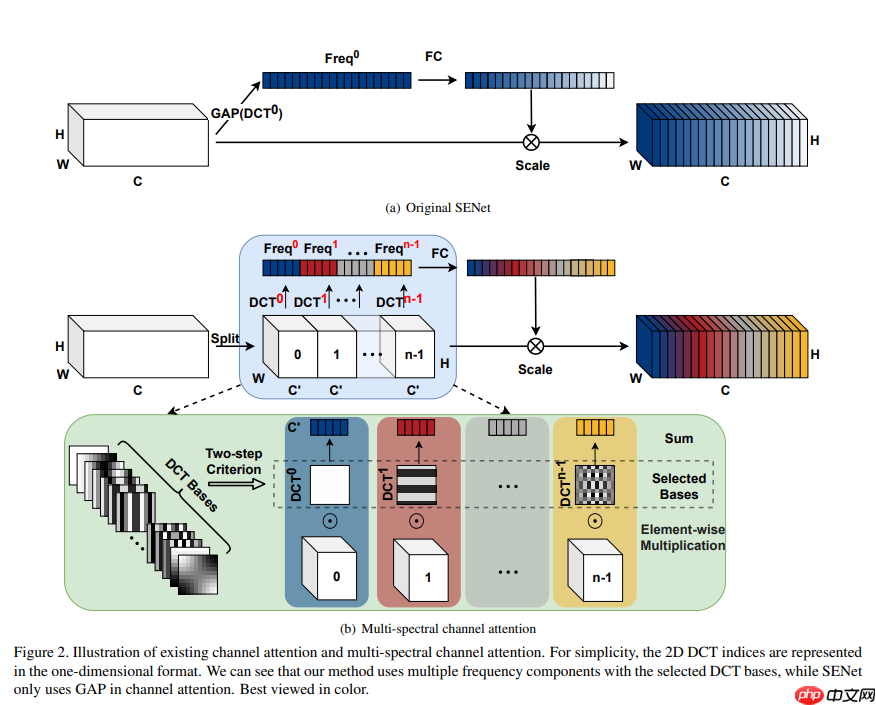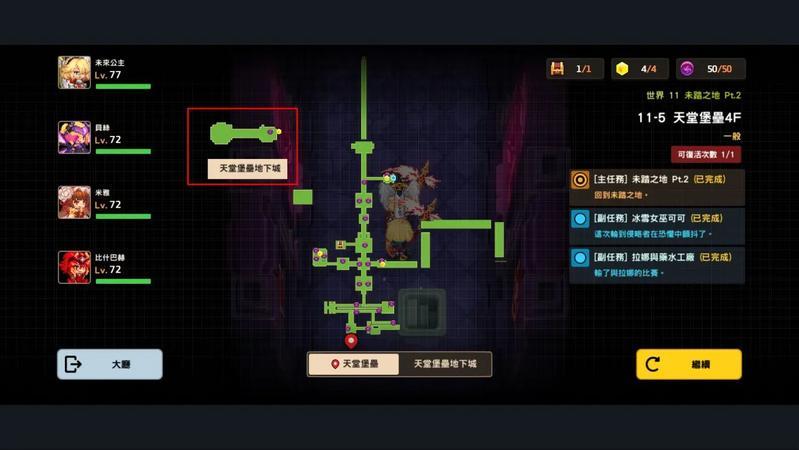Paddle2.0:浅析并实现 FcaNet 模型
时间:2025-07-18 作者:游乐小编
FcaNet通过频率域分析重新审视通道注意力,证明GAP是二维DCT的特例。据此将通道注意力推广到频域,提出多谱通道注意力框架,通过选择更多频率分量引入更多信息。实验显示,其在ImageNet和COCO数据集表现优异,基于ResNet时精度高于SENet,且实现简单。

引入
注意力机制,尤其是通道注意力,在计算机视觉领域取得了巨大的成功。许多工作专注于如何设计有效的通道注意力机制,同时忽略一个基本问题,即使用全局平均池(GAP)作为毫无疑问的预处理方法。在这项工作中,作者从不同的角度出发,并使用频率域分析(Frequency Analysis)重新考虑通道的注意力。基于频率域分析,作者在数学上证明了传统的 GAP 是离散余弦变化的特例。有了证明,作者自然地在频域上概括了通道注意力机制的预处理,并提出了具有新颖的 Multi-Spectral 通道注意力的 FcaNet(Frequency Channel Attention Networks)。相关资料
论文:FcaNet: Frequency Channel Attention Networks最新实现:cfzd/FcaNet主要贡献
证明了 GAP(Global Average Pooling) 是 DCT(Discrete Cosine Transform) 的特例。在此基础上,将通道注意力推广到频域,提出了基于多谱通道注意力(Multi-Spectral Channel Attention)框架的 FcaNet。通过研究不同频率分量数目及其不同组合的影响,提出了频率分量的两步选择准则。大量实验表明,该方法在 lmageNet 和 COCO 数据集上都取得了最新的结果。基于 ResNet 在相同的参数数目和计算代价下,它在 ImageNet 上的 Top1 精度比 SENet 高 1.8%。而且方法简单有效,只需在现有通道注意力实现中更改一行代码即可实现。通道注意力(Channel Attention)
通道注意力的权重学习如下式所示,它表示输入经过 GAP 处理后由全连接层学习并经过 Sigmoid 激活得到加权的 Mask。att=sigmoid(fc(gap(X)))
然后,Mask 与原始输入经过下式逐通道相乘得到注意力操作后的输出。X~:,i,:,:=attiX:,i,:,:, s.t. i∈{0,1,⋯,C−1}
离散余弦变化(DCT)
DCT 是和傅里叶变换很相似,它的基本形式如下:f∈RL 为 DCT 的频谱,x∈RL 为输入,L 为输入的长度。fk=i=0∑L−1xicos(Lπk(i+21)), s.t. k∈{0,1,⋯,L−1}
进而,推广得到二维 DCT 如下,f2d∈RH×W 是二维DCT的频谱,x2d∈RH×W 是输入,H 和 W 是输入的高和宽。fh,w2d=i=0∑H−1j=0∑W−1xi,j2dDCT weightscos(Hπh(i+21))cos(Wπw(i+21)), s.t. h∈{0,1,⋯,H−1},w∈{0,1,⋯,W−1}
同样,逆 DCT 变换的公式就如下了。xi,j2d=h=0∑H−1w=0∑W−1fh,w2dDCT weightscos(Hπh(i+21))cos(Wπw(i+21)), s.t. i∈{0,1,⋯,H−1},j∈{0,1,⋯,W−1}
上面两个式子中,为了简单起见,移除了一些常数标准化约束因子。DCT 变换属于信号处理领域的知识,是 JPEG 图像压缩的核心算法,相当于是对重要信息的聚集。其实从这里可以看出来,DCT 变换其实也是一种对输入的加权求和,式子中的余弦部分就是权重。因此,GAP 这种均值运算可以认为是输入的最简单频谱,这显然是信息不足的,因此作者引出了下面的多谱通道注意力。多谱注意力(Multi-Spectral Channel Attention)
这里作者首先按证明了 GAP 其实是二维 DCT 的特例,其结果和二维 DCT 的最低频分量成比例。这个证明作者是令 H 和 W 都为 0 得到的,其中 f0,02d 表示二维 DCT 的最低频分量,显然,从结果来看它与 GAP 是成正比。f0,02d=i=0∑H−1j=0∑W−1xi,j2dcos(H0(i+21))cos(W0(j+21))=1=i=0∑H−1j=0∑W−1xi,j2d=gap(x2d)HW
通过上面的结论,自然会想到将其他分量引入通道注意力中,首先,为了叙述方便,将二维 DCT 的基本函数记为:Bh,wi,j=cos(Hπh(i+21))cos(Wπw(j+21))
继而将逆二维DCT变换改写如下:xi,j2d=h=0∑H−1w=0∑W−1fh,w2dcos(Hπh(i+21))cos(Wπw(j+21))=f0,02dB0,0i,j+f0,12dB0,1i,j+⋯+fH−1.W−12dBH−1,W−1i,j=gap(x2d)HWB0,0i,j+f0,12dB0,1i,j+⋯+fH−1.W−12dBH−1,W−1i,js.t. i∈{0,1,⋯,H−1},j∈{0,1,⋯,W−1}
由这个式子其实不难发现,此前的通道注意力只应用了第一项的最低频分量部分,而没有使用下式表示的后面其他部分,这些信息都被忽略了。X=utilized gap(X)HWB0,0i,j+discarded f0,12dB0,1i,j+⋯+fH−1,W−12dBH−1,W−1i,j
基于此,作者设计了多谱注意力模块(Multi-Spectral Attention Module),该模块通过推广 GAP 采用更多频率分量从而引入更多的信息。
首先,输入 X 被沿着通道划分为多块,记为 [X0,X1,⋯,Xn−1],其中每个 Xi∈RC′×H×W,i∈{0,1,⋯,n−1},C′=nC,每个块分配一个二维 DCT 分量,那么每一块的输出结果如下式。
Freqi=2DDCTu,v(Xi)=h=0∑H−1w=0∑W−1X:,h,wiBh,wu,vs.t. i∈{0,1,⋯,n−1}
上式中的 [u,v] 表示二维 DCT 的分量下标,这就对每一块采用不同的频率分量了,因此下式得到最终的输出 Freq∈RC 就是得到的多谱向量,然后再将这个向量送入通道注意力常用的全连接层中进行学习得到注意力图。Freq =cat([ Fre q0, Fre q1,⋯, Freq n−1])
ms−att=sigmoid(fc( Freq ))
以上就是全部的多谱注意力模块的设计了,现在,下图这个FcaNet整体框架中间的一部分就看得明白了,唯一留下的问题就是对分割得到的每个特征图块,如何选择 [u,v] 呢?事实上,对空间尺寸为 H×W 的特征图,会有 HW 个频率分量,由此频率分量的组合共有 CHW 种,遍历显然是非常费时的因此,文中设计了一种启发式的两步准则来选择多谱注意力模块的频率分量,其主要思想是先得到每个频率分量的重要性再确定不同数目频率分量的效果。具体而言,先分别计算通道注意力中采用各个频率分量的结果,然后,根据结果少选出 Top k 个性能最好的分量。
代码实现
导入必要的模块
In [ ]import mathimport paddleimport paddle.nn as nnfrom paddle.vision.models import ResNet登录后复制
构建多谱注意力层
In [ ]def get_freq_indices(method): assert method in [ 'top1', 'top2', 'top4', 'top8', 'top16', 'top32', 'bot1', 'bot2', 'bot4', 'bot8', 'bot16', 'bot32', 'low1', 'low2', 'low4', 'low8', 'low16', 'low32' ] num_freq = int(method[3:]) if 'top' in method: all_top_indices_x = [ 0, 0, 6, 0, 0, 1, 1, 4, 5, 1, 3, 0, 0, 0, 3, 2, 4, 6, 3, 5, 5, 2, 6, 5, 5, 3, 3, 4, 2, 2, 6, 1 ] all_top_indices_y = [ 0, 1, 0, 5, 2, 0, 2, 0, 0, 6, 0, 4, 6, 3, 5, 2, 6, 3, 3, 3, 5, 1, 1, 2, 4, 2, 1, 1, 3, 0, 5, 3 ] mapper_x = all_top_indices_x[:num_freq] mapper_y = all_top_indices_y[:num_freq] elif 'low' in method: all_low_indices_x = [ 0, 0, 1, 1, 0, 2, 2, 1, 2, 0, 3, 4, 0, 1, 3, 0, 1, 2, 3, 4, 5, 0, 1, 2, 3, 4, 5, 6, 1, 2, 3, 4 ] all_low_indices_y = [ 0, 1, 0, 1, 2, 0, 1, 2, 2, 3, 0, 0, 4, 3, 1, 5, 4, 3, 2, 1, 0, 6, 5, 4, 3, 2, 1, 0, 6, 5, 4, 3 ] mapper_x = all_low_indices_x[:num_freq] mapper_y = all_low_indices_y[:num_freq] elif 'bot' in method: all_bot_indices_x = [ 6, 1, 3, 3, 2, 4, 1, 2, 4, 4, 5, 1, 4, 6, 2, 5, 6, 1, 6, 2, 2, 4, 3, 3, 5, 5, 6, 2, 5, 5, 3, 6 ] all_bot_indices_y = [ 6, 4, 4, 6, 6, 3, 1, 4, 4, 5, 6, 5, 2, 2, 5, 1, 4, 3, 5, 0, 3, 1, 1, 2, 4, 2, 1, 1, 5, 3, 3, 3 ] mapper_x = all_bot_indices_x[:num_freq] mapper_y = all_bot_indices_y[:num_freq] else: raise NotImplementedError return mapper_x, mapper_yclass MultiSpectralAttentionLayer(nn.Layer): def __init__(self, channel, dct_h, dct_w, reduction=16, freq_sel_method='top16'): super(MultiSpectralAttentionLayer, self).__init__() self.reduction = reduction self.dct_h = dct_h self.dct_w = dct_w mapper_x, mapper_y = get_freq_indices(freq_sel_method) self.num_split = len(mapper_x) mapper_x = [temp_x * (dct_h // 7) for temp_x in mapper_x] mapper_y = [temp_y * (dct_w // 7) for temp_y in mapper_y] # make the frequencies in different sizes are identical to a 7x7 frequency space # eg, (2,2) in 14x14 is identical to (1,1) in 7x7 self.dct_layer = MultiSpectralDCTLayer(dct_h, dct_w, mapper_x, mapper_y, channel) self.fc = nn.Sequential( nn.Linear(channel, channel // reduction, bias_attr=False), nn.ReLU(), nn.Linear(channel // reduction, channel, bias_attr=False), nn.Sigmoid()) def forward(self, x): n, c, h, w = x.shape x_pooled = x if h != self.dct_h or w != self.dct_w: x_pooled = nn.functional.adaptive_avg_pool2d( x, (self.dct_h, self.dct_w)) # If you have concerns about one-line-change, don't worry. :) # In the ImageNet models, this line will never be triggered. # This is for compatibility in instance segmentation and object detection. y = self.dct_layer(x_pooled) y = self.fc(y).reshape((n, c, 1, 1)) return x * y.expand_as(x)class MultiSpectralDCTLayer(nn.Layer): """ Generate dct filters """ def __init__(self, height, width, mapper_x, mapper_y, channel): super(MultiSpectralDCTLayer, self).__init__() assert len(mapper_x) == len(mapper_y) assert channel % len(mapper_x) == 0 self.num_freq = len(mapper_x) # fixed DCT init self.register_buffer( 'weight', self.get_dct_filter(height, width, mapper_x, mapper_y, channel)) # # fixed random init # self.register_buffer( # 'weight', # paddle.rand((channel, height, width))) # # learnable DCT init # self.register_parameter( # 'weight', # self.get_dct_filter(height, width, mapper_x, mapper_y, channel)) # # learnable random init # self.register_parameter( # 'weight', # paddle.rand((channel, height, width))) def forward(self, x): assert len(x.shape) == 4, 'x must been 4 dimensions, but got ' + str( len(x.shape)) # n, c, h, w = x.shape x = x * self.weight result = paddle.sum(x, axis=[2, 3]) return result def build_filter(self, pos, freq, POS): result = math.cos(math.pi * freq * (pos + 0.5) / POS) / math.sqrt(POS) if freq == 0: return result else: return result * math.sqrt(2) def get_dct_filter(self, tile_size_x, tile_size_y, mapper_x, mapper_y, channel): dct_filter = paddle.zeros((channel, tile_size_x, tile_size_y)) c_part = channel // len(mapper_x) for i, (u_x, v_y) in enumerate(zip(mapper_x, mapper_y)): for t_x in range(tile_size_x): for t_y in range(tile_size_y): dct_filter[i * c_part:(i + 1) * c_part, t_x, t_y] = self.build_filter( t_x, u_x, tile_size_x) * self.build_filter( t_y, v_y, tile_size_y) return dct_filter登录后复制
构建 FcaNet 模型
基于 ResNet 修改 Bottleneck 为 FcaBottleneckIn [ ]def conv3x3(in_planes, out_planes, stride=1): return nn.Conv2D(in_planes, out_planes, kernel_size=3, stride=stride, padding=1, bias_attr=False)class FcaBottleneck(nn.Layer): expansion = 4 def __init__(self, inplanes, planes, stride=1, downsample=None, groups=1, base_width=64, dilation=1, norm_layer=None, reduction=16): global _mapper_x, _mapper_y super(FcaBottleneck, self).__init__() # assert fea_h is not None # assert fea_w is not None c2wh = dict([(64, 56), (128, 28), (256, 14), (512, 7)]) self.planes = planes self.conv1 = nn.Conv2D(inplanes, planes, kernel_size=1, bias_attr=False) self.bn1 = nn.BatchNorm2D(planes) self.conv2 = nn.Conv2D(planes, planes, kernel_size=3, stride=stride, padding=1, bias_attr=False) self.bn2 = nn.BatchNorm2D(planes) self.conv3 = nn.Conv2D(planes, planes * 4, kernel_size=1, bias_attr=False) self.bn3 = nn.BatchNorm2D(planes * 4) self.relu = nn.ReLU() self.att = MultiSpectralAttentionLayer(planes * 4, c2wh[planes], c2wh[planes], reduction=reduction, freq_sel_method='top16') self.downsample = downsample self.stride = stride def forward(self, x): residual = x out = self.conv1(x) out = self.bn1(out) out = self.relu(out) out = self.conv2(out) out = self.bn2(out) out = self.relu(out) out = self.conv3(out) out = self.bn3(out) out = self.att(out) if self.downsample is not None: residual = self.downsample(x) out += residual out = self.relu(out) return outclass FcaBasicBlock(nn.Layer): expansion = 1 def __init__(self, inplanes, planes, stride=1, downsample=None, groups=1, base_width=64, dilation=1, norm_layer=None, reduction=16): global _mapper_x, _mapper_y super(FcaBasicBlock, self).__init__() # assert fea_h is not None # assert fea_w is not None c2wh = dict([(64, 56), (128, 28), (256, 14), (512, 7)]) self.planes = planes self.conv1 = nn.Conv2D(inplanes, planes, kernel_size=3, stride=stride, padding=1, bias_attr=False) self.bn1 = nn.BatchNorm2D(planes) self.conv2 = nn.Conv2D(planes, planes, kernel_size=3, padding=1, bias_attr=False) self.bn2 = nn.BatchNorm2D(planes) self.relu = nn.ReLU() self.att = MultiSpectralAttentionLayer(planes, c2wh[planes], c2wh[planes], reduction=reduction, freq_sel_method='top16') self.downsample = downsample self.stride = stride def forward(self, x): residual = x out = self.conv1(x) out = self.bn1(out) out = self.relu(out) out = self.conv2(out) out = self.bn2(out) out = self.att(out) if self.downsample is not None: residual = self.downsample(x) out += residual out = self.relu(out) return out登录后复制
/opt/conda/envs/python35-paddle120-env/lib/python3.7/site-packages/paddle/fluid/layers/utils.py:26: DeprecationWarning: `np.int` is a deprecated alias for the builtin `int`. To silence this warning, use `int` by itself. Doing this will not modify any behavior and is safe. When replacing `np.int`, you may wish to use e.g. `np.int64` or `np.int32` to specify the precision. If you wish to review your current use, check the release note link for additional information.Deprecated in NumPy 1.20; for more details and guidance: https://numpy.org/devdocs/release/1.20.0-notes.html#deprecations def convert_to_list(value, n, name, dtype=np.int):登录后复制
预设模型
In [ ]def fcanet34(num_classes=1000, pretrained=False): """Constructs a FcaNet-34 model. Args: pretrained (bool): If True, returns a model pre-trained on ImageNet """ model = ResNet(FcaBasicBlock, 34, num_classes=num_classes) model.avgpool = nn.AdaptiveAvgPool2D(1) if pretrained: params = paddle.load('data/data100873/fca34.pdparams') model.set_dict(params) return modeldef fcanet50(num_classes=1000, pretrained=False): """Constructs a FcaNet-50 model. Args: pretrained (bool): If True, returns a model pre-trained on ImageNet """ model = ResNet(FcaBottleneck, 50, num_classes=num_classes) model.avgpool = nn.AdaptiveAvgPool2D(1) if pretrained: params = paddle.load('data/data100873/fca50.pdparams') model.set_dict(params) return modeldef fcanet101(num_classes=1000, pretrained=False): """Constructs a FcaNet-101 model. Args: pretrained (bool): If True, returns a model pre-trained on ImageNet """ model = ResNet(FcaBottleneck, 101, num_classes=num_classes) model.avgpool = nn.AdaptiveAvgPool2D(1) if pretrained: params = paddle.load('data/data100873/fca101.pdparams') model.set_dict(params) return modeldef fcanet152(num_classes=1000, pretrained=False): """Constructs a FcaNet-101 model. Args: pretrained (bool): If True, returns a model pre-trained on ImageNet """ model = ResNet(FcaBottleneck, 152, num_classes=num_classes) model.avgpool = nn.AdaptiveAvgPool2D(1) if pretrained: params = paddle.load('data/data100873/fca152.pdparams') model.set_dict(params) return model登录后复制模型测试
In [ ]model = fcanet34(pretrained=True)x = paddle.randn((1, 3, 224, 224))out = model(x)print(out.shape)model.eval()out = model(x)print(out.shape)登录后复制
[1, 1000][1, 1000]登录后复制
/opt/conda/envs/python35-paddle120-env/lib/python3.7/site-packages/paddle/nn/layer/norm.py:648: UserWarning: When training, we now always track global mean and variance. "When training, we now always track global mean and variance.")登录后复制
精度测试
标称精度
解压数据集
In [ ]!mkdir ~/data/ILSVRC2012!tar -xf ~/data/data68594/ILSVRC2012_img_val.tar -C ~/data/ILSVRC2012登录后复制
模型评估
In [8]import osimport cv2import numpy as npimport paddleimport paddle.vision.transforms as Tfrom PIL import Image# 构建数据集class ILSVRC2012(paddle.io.Dataset): def __init__(self, root, label_list, transform, backend='pil'): self.transform = transform self.root = root self.label_list = label_list self.backend = backend self.load_datas() def load_datas(self): self.imgs = [] self.labels = [] with open(self.label_list, 'r') as f: for line in f: img, label = line[:-1].split(' ') self.imgs.append(os.path.join(self.root, img)) self.labels.append(int(label)) def __getitem__(self, idx): label = self.labels[idx] image = self.imgs[idx] if self.backend=='cv2': image = cv2.imread(image) else: image = Image.open(image).convert('RGB') image = self.transform(image) return image.astype('float32'), np.array(label).astype('int64') def __len__(self): return len(self.imgs)val_transforms = T.Compose([ T.Resize(256, interpolation='bicubic'), T.CenterCrop(224), T.ToTensor(), T.Normalize(mean=[0.485, 0.456, 0.406], std=[0.229, 0.224, 0.225])])# 配置模型model = fcanet34(pretrained=True)model = paddle.Model(model)model.prepare(metrics=paddle.metric.Accuracy(topk=(1, 5)))# 配置数据集val_dataset = ILSVRC2012('data/ILSVRC2012', transform=val_transforms, label_list='data/data68594/val_list.txt', backend='pil')# 模型验证acc = model.evaluate(val_dataset, batch_size=8, num_workers=0, verbose=1)print(acc)登录后复制{'acc_top1': 0.74838, 'acc_top5': 0.92048}登录后复制 小编推荐:
相关攻略
更多 - Claude怎么输入代码让它理解 正确格式和说明技巧解析 07.18
- 豆包AI怎么调试程序 豆包AI程序调试步骤 07.18
- MicrosoftOfficeExcel怎么进行数据分析 07.18
- 豆包回答不准确怎么提高准确率的提问技巧分享 07.18
- 用豆包AI生成Python游戏开发代码 07.18
- 豆包AI编程操作教程 豆包AI自动编程方法 07.18
- EasyEdge:PaddleX 2.0动态图检测模型的部署 07.18
- PointPillars:基于点云的3D快速目标检测网络 07.18
热门推荐
更多 热门文章
更多 -

- 神角技巧试炼岛高级宝箱在什么位置
-
2021-11-05 11:52
手游攻略
-

- 王者荣耀音乐扭蛋机活动内容奖励详解
-
2021-11-19 18:38
手游攻略
-

- 坎公骑冠剑11
-
2021-10-31 23:18
手游攻略
-

- 原神卡肉是什么意思
-
2022-06-03 14:46
游戏资讯
-

- 《臭作》之100%全完整攻略
-
2025-06-28 12:37
单机攻略
























